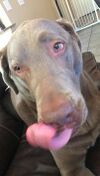BME100 s2018:Group7 W0800 L4
| Home People Lab Write-Up 1 | Lab Write-Up 2 | Lab Write-Up 3 Lab Write-Up 4 | Lab Write-Up 5 | Lab Write-Up 6 Course Logistics For Instructors Photos Wiki Editing Help | ||||||||||||||||||||||||||||||||||
OUR TEAM
LAB 4 WRITE-UPProtocolMaterials
Research and DevelopmentPCR - The Underlying Technology Q1. What is the Function of each Component of a PCR Reaction?Template DNA provides the DNA that is wanted to be copied. The primers attach to the sites on DNA strands at either end of the segment. The Taq Polymerase reads the DNA code and attaches the matching nucleotides. Deoxyribonucleotides is what the DNA consists of. Q2. What Happens to the Components During each Step of Thermal Cycling?During the initial step when it is at 95 C for 2 minutes and then allowed to denature at the same temperature for 30 seconds, the template DNA separates. Next, the DNA anneals at 57 C for 30 seconds and the primers block the two single DNA strands from rejoining together. Next, the DNA extends at 72 C for 30 seconds and the Taq Polymerase locates the sections the primers attached and adds complimentary nucleotides to the DNA and continues until it reaches the end of the strand and falls off. After the extend process the deoxyribonucleotides pair up at 72 C for 2 minutes to create a copy of the desired fragments. Q3. DNA Base PairingWhen considering DNA base pairs Adenine, Thymine, Cytosine, and Guanine, Adenine anneals to Thymine and Guanine anneals to cytosine and the reverse for each is true. Q4. During Which Two Steps of Thermal Cycling does Base-pairing OccurDuring thermal cycling, base-pairing occurs during the anneal step and the extend step. During the anneal faze the Taq Polymerase attaches the complimentary nucleotides to the DNA. During extend process, the deoxyribosenucleotides come together to create a new strand.
SNP Information & Primer DesignBackground: About the Disease SNP Single nucleotide polymorphisms are when there is variation at a single point in a person's DNA. More specifically, it is at a single point, where some people will have a different nucleotide. Most of the time, a single nucleotide polymorphism will not have a large affect because it won't change the amino acid it codes for. However, there will be an affect if it changes the amino acid. When this happens, the SNP can predict certain diseases and can play a role in the disease because it can change the function of a gene.
Our non-disease forward primer was 5'-TTCAGATGACTGCAAGGACA and our non-disease reverse primer was 5'-TGTTTAAAAGTTTCTTTAAT. Our disease forward primer was 5'-TTCAGATGACTGCAAGGACC and the disease reverse primer was 5'-TGTTTAAAAGTTTCTTTAAT. After conducting our primer test, we found that our non-disease forward primer and non-disease reverse primer has a match in the human genome. However, there was no match to our disease forward primer and disease reverse primer. 
| ||||||||||||||||||||||||||||||||||




